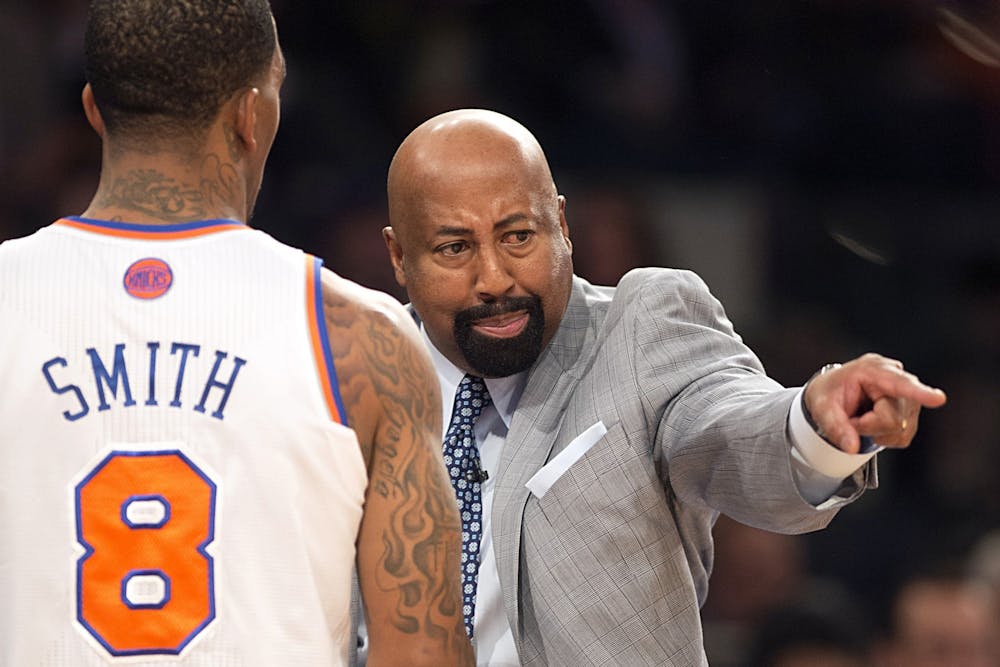In his 1957 book “Syntactic Structures,” renowned linguist Noam Chomsky penned the sentence “Colorless green ideas sleep furiously” to illustrate the concept that a string of words can be grammatically flawless yet seemingly nonsensical.
Likely tucked within that same chapter was the phrase “IU men’s basketball head coach Mike Woodson.”
To be fair, Woodson’s hiring didn’t completely come out of nowhere. After prophecies of Boston Celtics head coach Brad Stevens returning to the Hoosier state were deemed hearsay and talks with former Ohio State head coach Thad Matta fell through, Woodson quickly became the favorite to replace former IU head coach Archie Miller.
Still, I don’t think I was alone in initially being slightly underwhelmed. From what I could discern on Twitter, Woodson’s hiring didn’t set the IU fan base on fire as much as set it in the sunlight to get lukewarm.
Do you hear that? That’s the sound of thousands of diehard Hoosiers shrugging their shoulders and mumbling, “Yeah, sure, I think I remember the New York Knicks being pretty good in 2012.”
Cynicism aside, Woodson’s career speaks for itself as far as on-court acumen is concerned.
Between 11 years as an NBA player and numerous playoff visits as a coach for the Knicks and Atlanta Hawks, Woodson has essentially obtained an appreciable level of success in every facet of basketball he has entered.
That said, there is far more than the iconic Bucceto’s pizza space race to distinguish Assembly Hall from Madison Square Garden.
In the NBA, athletes are at least partially motivated by massive paychecks, sponsorship deals and contract incentives. It’s considerably easier to put forth an all star effort when doing so could buy a house with sufficient wall space to finally hang up all your Jackson Pollock originals.
College basketball means convincing a group of teenagers and 20-somethings to give their all on a Wednesday night at 9 p.m. during finals week. It also means convincing those teenagers and 20-somethings’ parents that your school can not only provide their child with a fulfilling athletic and academic experience, but potentially a path to join the less than 1% of high school seniors that wind up drafted by an NBA team.
I hesitate to put much stock into the fact that Woodson was a rather successful player at IU. Obviously, it never hurts to be familiar with a program and its locality, but I’m not sure how many Indiana high school basketball players are adorning their walls with Woodson iconography.
Then again, I could be overlooking the small but potent contingent of 17-year-old five-star phenoms who saw the life-size Isiah Thomas and Victor Oladipo stickers on Fathead.com and said to themselves, “No chance, I’m a Woodson guy all the way.”
Putting on a pair of crimson-tinted glasses, I can envision a timeline in which Woodson scrounges up underrated prospects, builds a tightly knit roster and reminds the college basketball world of how fantastic IU can be with a confident leader at the helm.
Nevertheless, the pessimist in me has serious reservations about Woodson’s ability to consistently rally his athletes. Part of that worry stems from the decades-wide age gap, but most of it has to do with the well-documented history of NBA coaches floundering at the collegiate level.
In his introductory press conference, Woodson declared his intent to speak with all six IU players currently in the transfer portal and convey to them the value of sticking things out in Bloomington, so the coming weeks should indicate how well Woodson can resonate with men 40 years his junior.
Above all, I just want the university and fan base to give Woodson time to do literally anything before writing him off as a failure.
Four seasons was plenty for Miller because his teams kept losing and did so in the exact same way over and over.
Woodson has been given a laundry list of pain points to address, but as long as he can cross off a couple early on I’ll feel optimistic. I don’t want to get my hopes up too high, but maybe next year IU can try only losing twice to Rutgers.



